Soybeans are amazing plants. Unlike our other major crop in Illinois, they’re not as cut and dried which is usually a good thing. Have a planter skip or early sprayer pass run over one or two plants across the row? Soybeans will bush out, add branches with extra nodes and pods, and use all those extra resources giving up no yield.
When it comes to nitrogen, soybeans keep that same approach of soaking up all of those extra resources they can find first before investing energy into fixing their own nitrogen. Soybeans use more nitrogen on a per acre basis than any other crop commonly grown in Illinois. The higher the yield environment, the higher the demand for nitrogen. If we are going to grow 70-, 80-, 90- or 100-bushel soybeans they will require about 350, 400, 450 or 500 pounds of nitrogen per acre, respectively. Those are daunting numbers, so let’s break them down and see how on earth we can get there as we explore a hypothetical growing season.

https://extension.entm.purdue.edu
Let’s assume we plant soybeans early in cooler three percent organic matter silt loam soil. Upon emergence, that seedling is going to be looking for a small amount nitrogen. I actually think it’s beneficial to have a small amount of nitrogen applied and available at emergence. Key word is small. I think it helps jump start plant growth and kick start their thirst for nitrogen. Within a couple of days after emergence, roots will be searching to associate with rhizobia bacteria to satisfy their season long insatiable search for nitrogen. These rhizobia form beneficial relationships with the crop roots. In exchange for sugars from the plant, the bacteria take nitrogen out of the air and convert it to ammonia for the soybean plant. For top yielding fields, we should be finding 8-20 healthy nodules per plant before flowering (R1). It’s worth pointing out that we shouldn’t confuse rhizobia nodules for soybean cyst nematodes. rhizobia nodules are larger and usually darker colored, as opposed to nematode cysts which are much smaller lighter colored and lemon shaped.
It is critical that we get these rhizobia nodule nitrogen factories established early in the season prior to flowering. The reason that I stressed a small amount of fertilizer nitrogen early season is because there isn’t much soil mineralization of organic matter until it warms up and we don’t want too much available nitrogen (from fertilizer or manure) because the soybeans will take the path of least resistance and use free nitrogen instead of investing energy into forming rhizobia nodules.
At flowering (usually the third week of June) our hypothetical soybean field has only taken up or fixed 20% of the nitrogen it will need to finish the season. Our soils have warmed up and heavy releases of organic nitrogen have begun. On our hypothetical three percent organic matter soil, we can expect 60-70 lbs. or more of nitrogen release. Our corn stalk residue from last year’s crop is holding 100-120 lbs. or more of nitrogen that is starting to release in the warmer soils as well. Our soybean crop in soaking up every scrap of slow release organic nitrogen it can find in the soil, but it still isn’t enough. Our rhizobia nodules will fix about 200 lbs. of nitrogen out of the atmosphere to help feed the crop.
For those of you adding as we are going, that should be enough nitrogen to get us between the 70-80 bushel yield level assuming breakdown of organic matter and sufficient corn stalk residue. In good conditions we can get more than anticipated nitrogen from the soil, corn residue and rhizobia. It’s worth mentioning that if we try to apply a time release fertilizer or a late application of nitrogen that introduces too much nitrogen too quickly late season, plants will back off investing in the rhizobia fixed nitrogen and utilize the fertilizer nitrogen first. I think soybeans always taking the path of least resistance is why we struggle to see consistent economic returns to nitrogen applied to soybeans. I think this also helps explain why most contest winning soybean yields are produced on higher organic matter fields following a high-yielding corn crop with higher amounts of stover.




 and then
and then